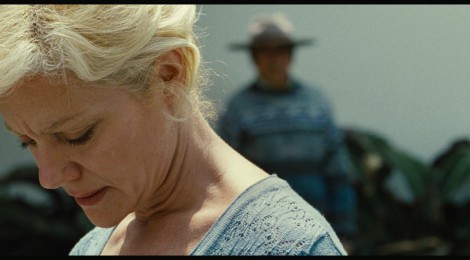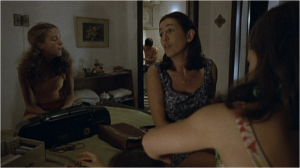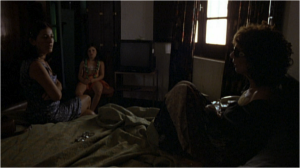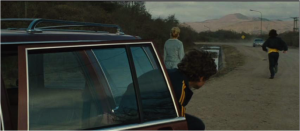
The Link Between Funding and Text: Transnational Aesthetics in Lucrecia Martel’s Films
Mediatico presents an entry by Dolores Tierney, one of the founding editors of this blog, on the connection between Latin America’s art house boom and European and US funding bodies. It is taken in part from her forthcoming book Contemporary Latin American Cinema: New Transnationalisms.
A core point of enquiry of a new journal from Intellect (Transnational Cinemas), and the subject of several prominent anthologies (Newman and Ďurovičová 2010; and Ezra and Rowden, 2006), transnational cinema has become an insistent theme in contemporary film studies. In Latin American film studies, it has become central to our understanding of the region’s cinemas not just because of the contemporary phenomena of Latin American directors and personnel working across borders but also because of the proliferation of inter-regional and transatlantic funding practices, agreements and arrangements from the mid 1990s onwards.
And yet, the increasing mobilization of the concept of the transnational also presents problems to the geospatial, political and postcolonial paradigms of Latin American film scholarship. The transnational as a theoretical paradigm threatens to decentre the national and consequently the cinema’s role in Latin America’s nation building projects of the twentieth century. It also threatens to frame the cinemas of the Global South in an unproblematically globalized economy that doesn’t take into account the “inequalities of production and distribution” (Page 2009: 10) that constrain Latin America’s filmmaking endeavours. And, according to its most stringent critics, the transnational as a ruling paradigm in the exploration of Latin American cinema threatens to efface the many films produced in favour of the few, ultra successful, seemingly over-exposed and atypical “blockbusters” (Amores perros, Y tu mamá también, El hijo de la novia, Cidade de deus, Diarios de motocicleta, Nueve Reinas, El secreto de sus ojos) which have successfully crossed over in global commercial markets.
In the case of Argentina the pared down aesthetics of the New Argentine cinema of Martel, Trapero, Alonso and others are perceived as being a million miles away from the more grandiose and elaborate visuals of the Argentine blockbusters (Nueve Reinas, El hijo de la novia, El secreto de sus ojos), but there is also a means by which we can draw a line of connection between these films and the New Argentine Cinema directors. Whilst we tend to think about Argentina’s “industrial auteurs” –Juan José Campanella (El secreto de sus ojos 2009), Fabián Bielinsky (Nueve Reinas 2000, El Aura 2004), and Marcelo Piñeyro (Plata Quemada 2000)– as interacting with and influencing a transnational exchange between Argentina, the US and Europe in the way their films engage with aesthetic global trends or with popular genre templates more commonly found in Hollywood, (but unlike the Mexican and Brazilian directors Alejandro González Iñárritu, Guillermo del Toro, Alfonso Cuarón, Walter Salles and Fernando Meirelles, not in their displacement to first world film industries – Campanella has worked only in U.S. “quality” television), it is equally the case that Martel and other new Argentine directors are similarly involved in a transnational dynamic . What’s most interesting about Argentina, within a framework of transnationalism, and in particular the work of Martel, is that it adds another critical dimension to the idea of transnational cinema in Latin America, other than that of the well known hugely successful films or the limited in number official co-productions, presenting an alternative form of transnationalism not based strictly on commercial partnerships but on something else instead. This blog entry will look at the dimensions of this transnationalism linking the discussion of the transnational funding structures of principally La ciénaga (2001) but also La niña santa (2004) and La mujer sin cabeza (2008) with the textual exploration of the film texts.
Funding the nuevo cine argentino
Whereas the early 1990s saw the dismantling of the state infrastructure and support for the film industry in Mexico and Brazil, pushing both industries to the verge of collapse, in Argentina under President Menem the industry was “spared and even nurtured” with various legislations directing funding towards the production of a national cinema and seeking out partnerships with television companies (Falicov, 2000: 327). The model Menem “looked to” for the Argentine industry was the U.S. film industry –big budgeted films with special effects— seeking to foster not the art cinema practices of national cinema from previous administrations but a cinema with “industrial capabilities.” (Falicov 2000: 236) However, in the mid 1990s there was also an attempt on the part of the state to foster low budget filmmaking by first time filmmakers. The moment of and reasons for the emergence of the New Argentine cinema at this point have been pinpointed/attributed to the collective forces of a low budget film fund initiated by INCAA the state film institute, the revival of the film festival in Mar de Plata (where in 1997 the “first” new Argentine cinema film, Caetano and Stagnaro’s Pizza, birra, faso won the special jury prize) the establishment of the Buenos Aires International Festival of Independent Film, the proliferation of private and state funded film schools, and finally a new generation of “savy” producers capable of navigating the complex requirements of foreign funding bodies (Aguilar 2011: 8). Significantly, as Aguilar points out foreign institutions and film festivals; Hubert Bals (attached to the Rotterdam Film Festival and supported by the Dutch Government), Fonds Sud (administrated through the French Ministry of Foreign Affairs), Sundance (attached to the festival and institute of the same name) and, Ibermedia (an Iberamerican transatlantic funding body with 13 member countries including Spain) as well as their related competitions have also played a key role in the promotion and funding of the New Argentine Cinema with “[a]lmost all” of its films receiving “sponsorship from one of these sources” (2011: 12). When an early masterpiece of new Argentine Cinema, Martín Rejtman’s Rapado/Skinhead (1995) was turned down by INCAA, funding from the Hubert Bals fund ensured it was completed (Falicov 2007: 116; Aguilar, 2011: 12). What Aguilar argues is so significant about the financial assistance offered by foreign institutions, film festivals and their related competitions is not necessarily the amount (Fonds Sud award for La mujer sin cabeza represented only 90,000 euros of a total budget of 1.71 million euros).[1. Fonds Sud website. (http://www.diplomatie.gouv.fr/en/france-priorities_1/culture-media_7354/cinema_2/cinematographic-cooperation_9/production-support-funding_10/fonds-sud-cinema_11/commission-results_738/commission-of-the-6th-june-of-2007_10736.html?var_recherche=Martel).] but that it gives “access to other economic resources” (2011: 12) –in such a way that winning one funding competition singles-out scripts or incomplete features as attention-worthy for other festivals and ultimately distributors. And ironically these “other” […] resources” whose interest is often piqued by foreign financial assistance has included the INCAA itself. The story of how Alonso’s first feature film La libertad (2001) was completed is illustrative here of this particular process. Not being able to even apply to INCAA because of its script based funding application (which admittedly is the same with most funding competitions in Europe and North America) during pre production or production, Alonso only received state support (of $70,0000 postproduction funds) when a Cannes’ delegate (on a scouting trip to Argentina) expressed interest in showing the film in ‘Un Certain Regard’ section of the Festival (Matheou, 2010: 293). And it is not just foreign funding which has nudged INCAA towards greater support of the nuevo cine argentino. As Aguilar points out, the state was forced into it “in light of the impact of these movies on the festival circuit and their prestige among critics.” (2011: 12)
Martel’s La ciénaga, La niña santa and La mujer sin cabeza were all funded by a system of support which included both funding from the state and from a variety of foreign sources. In the case of La ciénaga one of the most prominent instances of foreign funding took the form of an award of $200,000 from the Sundance/NHK script writing competition which facilitated the script’s development at a scriptwriting lab. Other funding parties included Fonds Sud, Ibermedia and Wanda Vision – a Spanish production company. La niña santa has a similar funding structure that included Pedro Almodóvar’s production company El Deseo S.A., and Fonds Sud. La mujer sin cabeza was similarly funded by Fonds Sud, El Deseo S.A., and Arte France, (a French TV channel which has funded some of the new Mexican films such as Carlos Reygadas’ Batalla en el cielo). Martel’s films are to a certain extent typical not just of recent Argentine critical successes but also of several recent Latin American successes. In many ways, the Latin American critical and art house renaissance is being bankrolled by these transnational funding structures. Just to give some other examples, Peruvian Claudia Llosa’s Madeinusa (2006) and Mexican Fernando Eimbcke’s Lake Tahoe were also developed at the Sundance scriptwriting lab. Alonso’s Liverpool (2008) received funds from Hubert Bals whilst his La libertad received funds from Fonds Sud.
Tamara Falicov has explored the complex cultural politics of the funds that stem from European international festivals (2010). She has argued that, useful as they are in the variety of filmmaking activities they fund and facilitate: script development, preproduction, completion, striking prints, exposure and, in the case of those with markets attached, distribution deals, funding awards given by European countries to Latin American or other developing countries like Fonds Sud, Hubert Bals and others are inevitably characterized by a colonial power dynamic both in their “exploitation of the cultural resources of the South” to enrich the global festivals of the North (where the awarding of completion funds is often about “producing [innovative] content for [what are essentially competing] festival[s]” (Falicov 2010: 5)) and in their prescriptive demands about stereotypical features in scripts. She suggests that funders have an influence on the content and style of films from the global south when the aesthetic criteria with which films are chosen is based on the tastes and aesthetic qualities that appeal to their Western audiences.[2. I haven’t found any suggestion in the literature or interviews that Martel experienced any of these prescriptive demands with her scripts (though there is anecdotal evidence about Sundance Institute suggesting she pared down La ciénaga’s plot to involve less characters).]
So following Falicov what is effectively produced in the film festival circuit through a larger “system” of facilitation and encouragement, could be thought of as a “a transnational aesthetic” (2010: 5). And this is particularly underlined in the case of Martel and others of the New Argentine Cinema like Alonso who find success (and indeed exhibition) on the festival circuit, but very little exhibition or indeed audience in their home countries. Through the textual exploration of La ciénaga and La mujer sin cabeza we can suggest some ways of thinking about Martel as a director who participates in a kind of cinema that in Marijke de Valck’s words “stimulates a transnational approach to cinema” and pin down the function of her transnational aesthetics (2007: 109).
The function of Martel’s transnational aesthetics
Martel is in some ways a case set apart from nuevo cine argentino and the broader art-house renaissance in Latin American cinema. Her films depart from the minimalist and strict neo-realism of the films of Alonso, Trapero, Eimbcke, Escalante and others, not making use of location shooting or obsessively exploring the quotidian –though sometimes still using non professional actors and taking on the democratic and egalitarian aesthetic proper to the Italian movement and celebrated by Bazin (Matheou 2010: 302, Gundermann 2005: 255, Stam 2000: 74). And yet, her films do conform to some shared aspects of the continent’s cinematic rebirth, of broader trends in world cinema, and of the transnational aesthetics of the festival film -particularly with respect to their use of realist techniques. In what follows I want to explore the function of Martel’s transnational aesthetics in La ciénaga but also La mujer sin cabeza and how it may connect to the cultural imperatives of a transnationalized sphere.
Martel’s three films share common realist techniques –all with the aim of interrogating the reality they portray, rather than straightforwardly presenting it in observational mode. In La mujer sin cabeza Vero’s speedy drive along the canal takes place in one long take. The sequence begins as computer game-like point of view shot before re-framing to a side-on shot of her as she reaches in her handbag to find her ringing phone. The collision, stopping, hesitation and continuation on her way all happen in an extended take (of about one minute). The long take here, a cornerstone of Bazinian realist aesthetics serves to emphasize not just the duration of the bone crunching impact and driving over of something or someone but also the relatively short amount of time Vero takes to hesitate over whether to go and see who or what she has hit. The focus on the event that the long take brings, heightens the film’s critique of Vero’s class, not just its lack of interest in the fate of the poor/and indigenous who serve and live alongside them, but also as the narrative develops, of that same class’s implied disavowal of the disappearances and violence of the “dirty war.” At the same time, the child’s hand prints visible on the window next to Vero’s head and caught in the sunlight, in addition to acting as a “trace” of the accident’s possible victim (or equally of the middle class children who crowded round the car earlier but were safely ushered into their own cars) also act like a Bazinian “fingerprint”: “shar[ing] a common being” (2005:15) with the object (or in this case subject) they represent and further underscoring the film’s commitment to realism.
Long takes in Martel, are sometimes partnered with another key realist technique the framing of depth of field or what Bazin called the “dramatic checkerboard” where each area is important and hence must be “planned down to the last detail” (2005: 34) (although sometimes, unlike Bazin’s checkerboard the background is not always totally in focus). In La ciénaga there are several uses of deep space that are significant to the dramatic action. In certain scenes at the ramshackle country house, the Mandragora, characters enter the bathroom that is off Mecha’s bedroom and their ablutions are performed in full sight of the assembled crowd in the room. In one scene for instance, José enters the bathroom with his trousers undone and underpants showing and proceeds to wash and apply deodorant
In other scenes, Tali and Mecha converse whilst Momi, or Tali’s youngest daughter or Gregorio sulk in the background.
Here the background characters’ faces (in this case Tali’s daughter) offers a commentary on the banality of what the two women talk about (school supplies etc). Deep space is also used to great effect in La mujer sin cabeza to recall the accident. When, on the same canal road, her cousin’s son runs to collect a shoe tossed out a car window, his position vis a vis a car speeding towards him is too much for Vero. She turns away
The use of deep space in this instance positions both the echo of the accident and Vero’s reaction to that echo within the same frame suggesting her growing suspicion that she injured a child and her inability to face that realization (she turns away as the boy heads towards the car). A further echo of the accident in the following scene an injured boy crumpled on the football field provokes Vero’s momentary breakdown.
From these analyses, the basis of Martel’s transnational aesthetics becomes a transnationally defined art cinema realism that dialogues with previous realist traditions and theories. And this realism as a project in Martel’s films can be connected both with a broader realist revival in world cinema of which new Argentine cinema and Latin America’s contemporary cinema is a part, and a “historical chain of film cycles” (Nagib & Mello, 2009: xiv) starting from neorealism but continuing through the European new waves, into the Latin American new cinemas of the 1960s and culminating perhaps in the Dogme ’95 movement. It is on these realist and innovative credentials, but often under the guise of “cultural diversity” (as stated on a Fonds Sud’s website).[3. http://www.filmfrasor.no/en/program/Fondsud.] that films like La ciénaga and La mujer sin cabeza present cultural capital to the film funds, television stations and festivals of the North which provide the monies for their development or completion. In the realist aesthetics of their cinema they offer an authenticity supposedly not present in the classical, industrial cinemas of the North. It’s also worth noting that La ciénaga’s temporal dislocation (where time and duration seem to be of no concern to anyone – as the inhabitants of La Mandragora indulge in a perpetual siesta) familial dysfunction, non classical plot line and ensemble cast also connect it to the movement with which its supporter the Sundance Institute is most closely associated, American Independent Cinema and its particular classics (Welcome to the Dollhouse, Todd Solondz 1995, Happiness Solondz, 1998 The Royal Tenenbaums, Wes Anderson 2001) (Sconce 2002). As such, this film, and Martel’s others, is perhaps like many of those films from the periphery funded by the metropolis. As well as reflecting back to the centre its idealized image of itself, they reflect a comfortingly strange picture of the other. These European and North American festivals, TV stations, and funding bodies find cultural worth in the expression of the marginalized (Falicov 2010:14), as it reflects on marginalization, which in the case of Martel and La ciénaga or La mujer sin cabeza would be the representation of a decadent middle class who are themselves at the peripheries of the global economy but who nevertheless occupy a better position than the marginalized peoples of the Fourth World who function as their servants.
LIST OF WORKS CITED
Aguilar, Gonzalo (2011) New Argentine Film: Other Worlds Palgrave Macmillan.
Bazin, André (2005) “The Ontology of the Photographic Image” “The Evolution of the Language of Cinema” What is Cinema? Trans. Hugh Gray, Berkeley and Los Angeles: University of California Press, 9-16, 23-41.
De Valck, Marijke (2007) Film Festivals: From European Geopolitics to Global Cinephlia Amsterdam UniversityPress.
Falicov, Tamara (2010) “Migrating from South to North: The Role of Film Festivals in Funding and Shaping Global South Film and Video” Locating Migrating Media eds Greg Elmer, Charles H. Davis, Janine Marchessa and John McColloughLanham MD: Lexington, 3-22.
— (2007) The Cinematic Tango: Contemporary Argentine Film London: Wallflower.
— (2000) “Argentina’s blockbuster movies and the politics of culture under neoliberalism, 1989-98” Media, Culture and Society 22.3, 327-342.
Gundermann, Christian (2005) “The Stark Gaze of the New Argentine Cinema”
Matheou, Demetrios (2010) The Faber Book of New South American Cinema London: Faber & Faber.
Newman, Kathleen and Natasa Durovicova (2010) World Cinemas: Transnational Perspectives New York, Routledge.
Nagib, Lúcia and Cecília Mello. (2009) Realism and the Audiovisual Media Palgrave Macmillan.
Page, Joanna (2009) Crisis and Capitalism in Contemporary Argentine Cinema Durham and London: Duke University Press.
Sconce, Jeffrey (2002) “Irony, Nihilism and the new American ‘smart’ film” Screen 43.4, 349-369.










